Presidents: Dwight David Eisenhower
Eisenhower Birthplace State Historic Site, Denison, Texas
Visited in 2017.
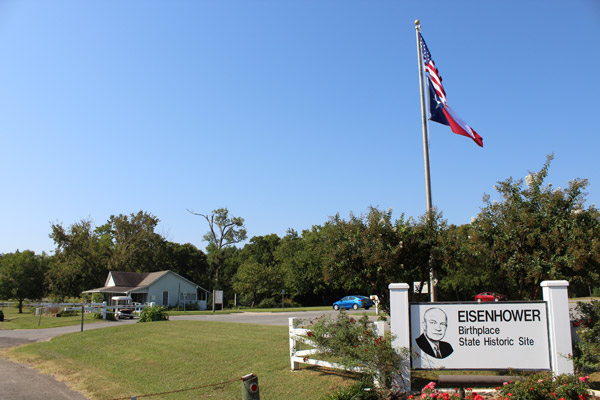
Rolling up on the visitors center in Denison.
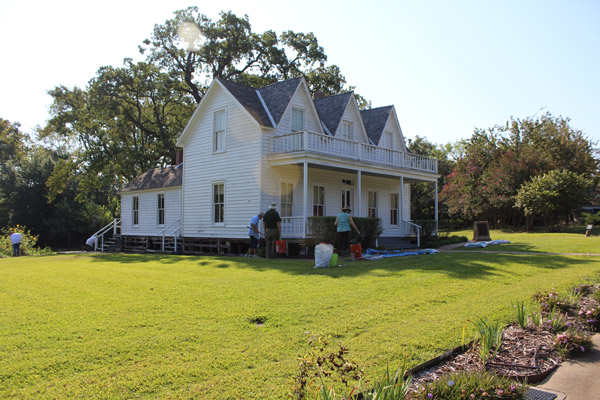
The rental home where the man who beat Hitler was born.
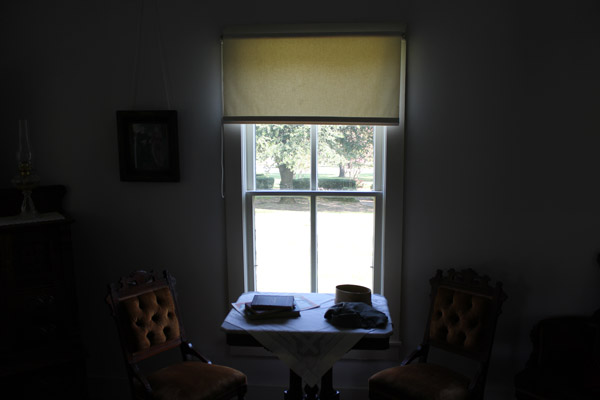
Do they have period-appropriate furnishings? OH YEAH!
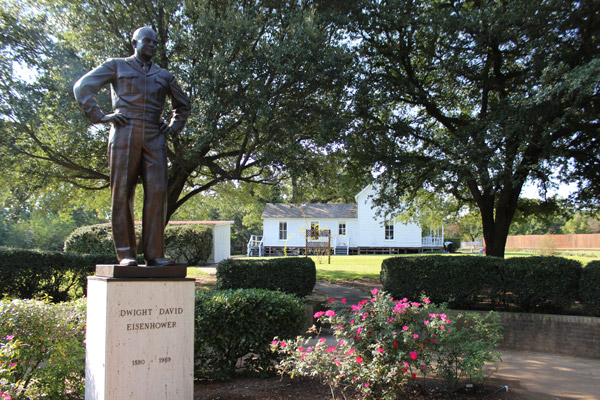
The memorial butterfly garden, celebrating Ike's tramp stamp.
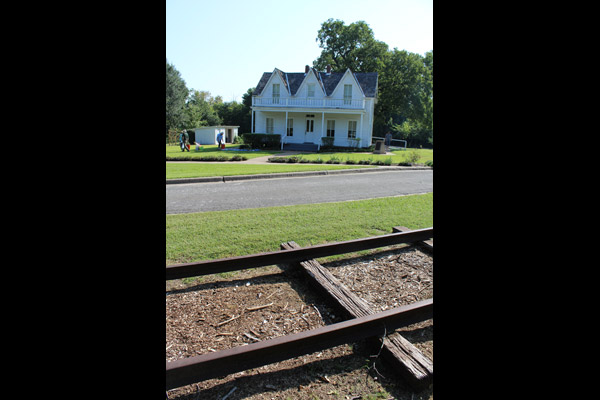
This is how close the tracks were. Fun!
Hitler made a number of errors in his attempt to conquer the world. But his primary error was messing with Texas.
Most people -- including Dwight Eisenhower -- would say Dwight Eisenhower was a Kansan. Asked once where he was born, the adult Dwight deferred to his mother. For a great deal of his life, he didn't know the answer, because in the early 20th century parents didn't have to tell their kids jack s***. It was a simpler and better time.
But history tells us that the 34th president was born in Denison, 75 miles north of Dallas and just inside the border with Oklahoma. Denison started as a railroad town, and the KATY Railroad is what drew the Eisenhowers in 1889. Ike's father, David, needed a railroad job after running out of Hope. That capitalization isn't dramatic; David was running a general store in Hope, Kansas, and the failure of that store left his family on the brink of ruin.
Fortunately, the KATY needed someone to ... uh, help them wipe. David found work as a "wiper," earning horrible wages by cleaning dirty engines. (The was only marginally better than cleaning cabooses, the job of the ass wipe.) After stashing away some wiping paper, he sent for his wife and two kids.
They all came to regret it. The Eisenhowers rented a home on Lamar Avenue, which was great for David's commute -- because it was about 100 feet from the railroad tracks. The trains were loud, smelly and disgusting, coating the home (inside and out!) with an ever-regenerating layer of soot. And while they had some less sophisticated ideas about child care in the late 1800s, no one was under the impression that soot did a body good. Theoretically, David had the skills he needed to wipe down the house, but who wants to bring work home? His wife, Ida, was also slammed with housework, because without running water normal chores took 27 hours a day to complete. They were tired, far from their extended families, and still kind of poor.
Therefore, when presented with an opportunity to leave that hellhole, they took it. David found another job as a refrigeration engineer for the Belle Springs Creamery. In 1892, he traded the soot of Denison for the giant cloud of cow farts that surely enveloped Abilene, Kansas.
But the family was in Denison long enough to add a third child. Dwight was born in October 1890, inside that Lamar Avenue rental. He lived in the home for only 18 months before the move to Abilene, but the history gods smiled on the simple structure. The house was built in 1877, so it hadn't decayed too badly by the time Eisenhower was kicking butt in Europe. The people of Denison quickly realized the value of having the birthplace of the most famous man in the world, so they acquired the home in 1946. Toward the end of his presidency, the property was converted to a state park.
They house today seems to be in great shape, probably because the railroad no longer runs trains 100 feet away. The whole town is cleaner. Since soot is no longer a factor, you see a quaint, white two-story structure. The inside has been furnished in the style of the 1890s, and our docent gave a very solid guided tour. (Considering how tiny the house is, that's no small feat.) There also a reading-heavy mini-museum stashed away in a nearby visitors center, and a nice Eisenhower statue in the middle of a butterfly garden.
All of Eisenhower's formative experiences were in Kansas. But we should thank the people of Denison for keeping Ike's real origin story alive. The great savior of democracy was the son of a wiper. Hitler never had a chance.
Presidential Library, Museum and Boyhood Home, Abilene, Kansas
Visited in 2010.
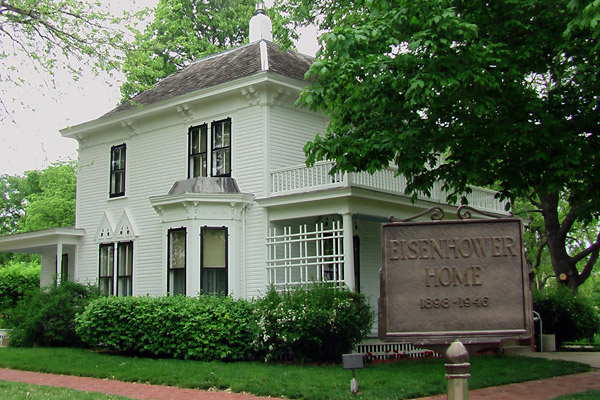
Good things come in small packages, right?
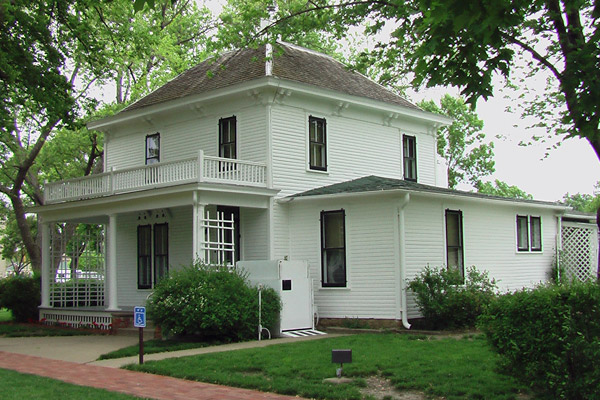
The view from the back. It's a small house regardless of the angle.
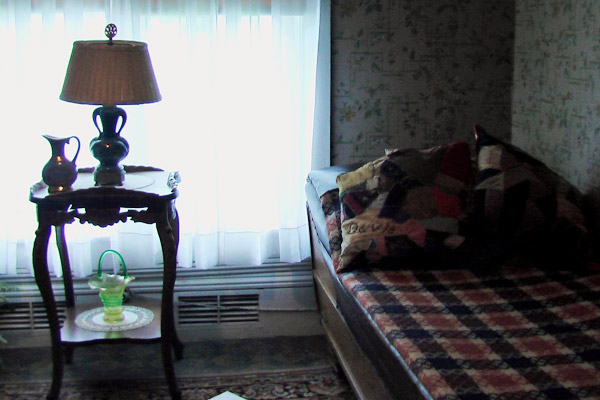
The inside of Ike's boyhood home. Thank god they had a big yard.

I promise you it never looked this relaxed when six boys lived there.
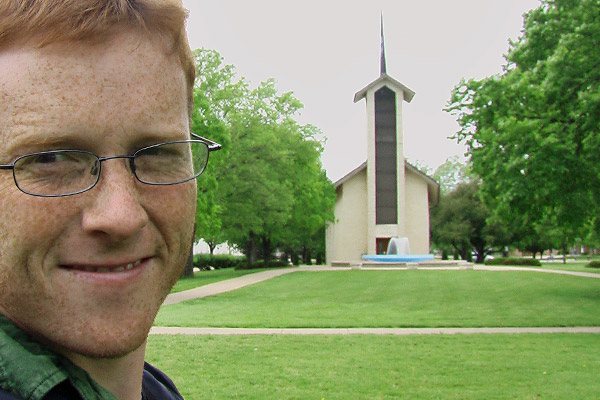
Across the lawn from the chapel where Dwight and Mamie are buried.
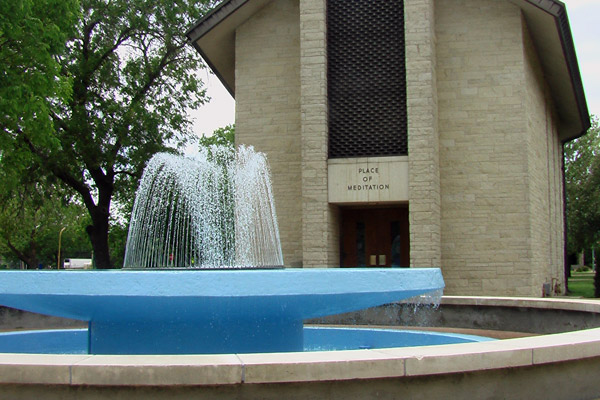
Hitler couldn't beat DDE, but Father Time is undefeated.
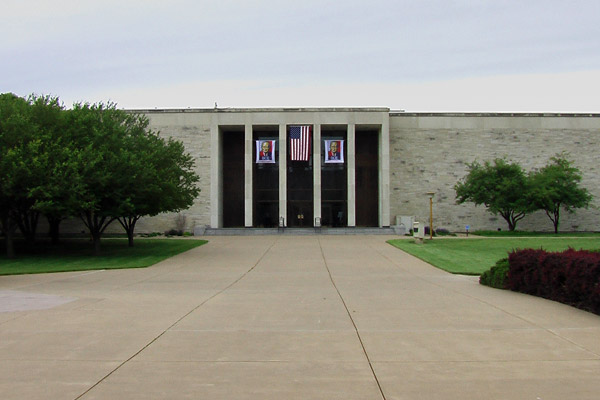
The not-very-exciting-looking library and museum.
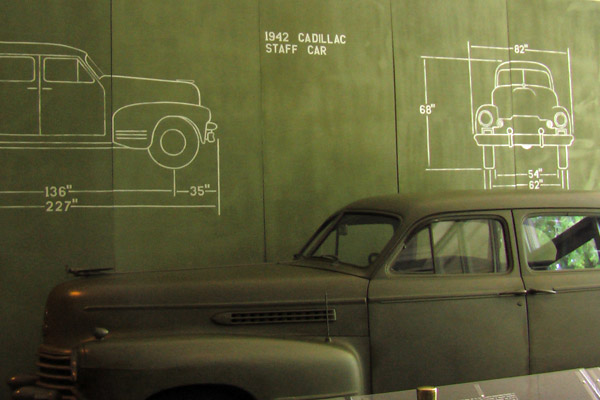
Eisenhower's staff car, which he used to do donuts on Hitler's lawn in 1945.
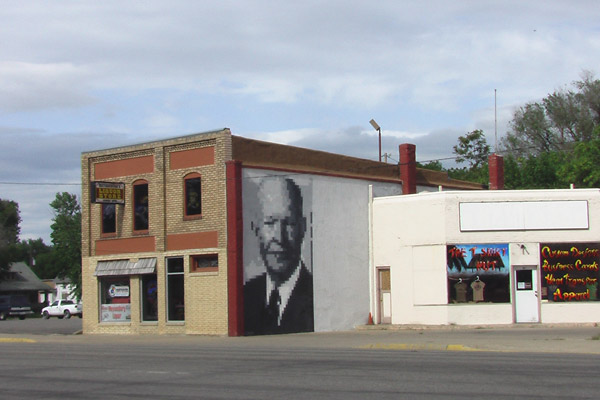
My favorite liquor store ever. God, I hope this still exists.
Dwight Eisenhower is remembered as a logistical genius, and it probably all started in Abilene. He was raised in a very tiny house with eight other people. It had only one bathroom. If you can figure out that amphibious adventure, landing at Normandy is child's play.
Eisenhower always copped to the importance of his upbringing. Getting a hero's welcome in New York, he made sure to plug his hometown of Abilene: "I'm just a Kansas farm boy who did his duty." Truthfully, it wasn't much of a farm, though. Abilene was a cow town. (Fun fact: Bill Hickok was a marshall there, back in the day.) The Eisenhower property was less than 3 acres, on the wrong side of the tracks -- literally, you can throw a rock and hit the tracks. It was just a few blocks from main street. The Eisenhowers had their house, a barn (which is long gone), a garden and a few other outbuildings. It was enough to keep the family self-sufficient, but it wasn't exactly Mount Vernon. Dwight's father worked as a mechanic for a creamery, and his mother kept the house.
But man, did they do right by their kids. David and Ida Eisehower has seven children, all of them boys. One died before his first birthday, but the rest made it to adulthood. Usually with a family that size, a few of the kids are duds. Someone is going to rob a bank, or kill a hooker, or end up as the bass player in a tribute band. Not so for the Eisenhowers: Dwight was a great general; Milton became a super-wonk and university president; and the rest seemed to have pretty decent lives. They were hell-bent on education; Dwight actually worked out a deal with his brother Edgar, where they'd take turns going to college and working to pay for that college. Edgar went to school first, while Dwight got a job at the creamery. He eventually let Edgar off the hook by getting into to West Point, where tuition is on the government.
Me, I'd force a sibling to work in a sewer if it meant keeping things square. But I'm pretty comfortable saying that Dwight Eisenhower is better than me.
It really was an All-American upbringing, between the farm chores and the public schooling and playing baseball and football with his brothers in the yard. Everyone had to take piano lessons -- the piano is still on display in the parlor -- and there was a healthy midwestern smattering of Jesus. Most important, all the boys loved their momma. When Ida died in 1946, the brothers got together to preserve the house as a museum dedicated to their parents. It's the reason you can still visit that house today. Dwight Eisenhower: He freed Europe, AND he loved his mom. Adlai Stevenson never had a chance.
It takes about five minutes to see the house, because it really is THAT small. But there's more Eisenhower stuff to see in Abilene. After leaving Abilene for West Point, Eisenhower only visited his hometown -- he never lived there again. But it had enough of a place in his heart that he put his presidential library there, assuring that generations of nerds would bolster the local economy by flocking there with research requests in hand. The boyhood home is part of the library's campus now, so once you see the house, you're just a short stroll from a museum dedicated to Dwight. And I gotta say: meh.
It's not BAD (circa 2010, at least), since it walks you chronologically through his very interesting life. But it's just not personal enough. The World War II section is huge, but it's more of a blow-by-blow accounting of the major battles. You can get that anywhere. It's nice to know that the British Field Marshal Bernard Montgomery had some ideas about attacking the Nazis from the north; but it's fascinating to know that Ike did not like Monty, considered him a glory hog, hated most of his plans and ultimately had a very hard time controlling him. That strained relationship had profound effects on the course of the war and thousands of lives, but you won't learn about it in the museum.
Another example: most of the "Mamie" section is about the dresses she wore. That's fun, but not as intriguing as how she handled wandering the globe and years-long separations from her husband. They have every surviving letter that Dwight wrote, about 300 feet away in the library; why not use them? That said, I will confess to liking Ike's inaugural suit, a recreation of his post-presidency office at Gettysburg College, the class ring he used to propose to Mamie, and the severed head of Joseph Goebbels, all of which are on display.
But whether you like the museum or not, you can get some closure on the Eisenhower story. Dwight and Mamie are resting nearby in a little chapel. The sign says it's a "place of meditation," and even with its distinctly 1970s feel I liked it. The happy couple (and a son who died very young) are under simple slabs, set a bit below floor level. There's a fountain and some flowers, and the walls have a few quotes from the general about humility and the need for peace. If you want you can sit in a pew at the back of the building, where light comes in through some simple stained-glass windows. There's a constant hum of climate control to go with the fountain noise, but you can definitely park it for a few minutes and meditate, assuming gum-snapping teenage girls don't come in and start texting while you contemplate one of the most important leaders of the 20th century. If those girls depress you, never fear. You can also drive down Buckeye Street a few blocks, to contemplate at the interesting mural of Eisenhower on the side of a building. Your meditation will be helped by the fact that the building is a liquor store.
Eisenhower National Historic Site and Offices, Gettysburg, Pennsylvania
Visited in 2008 and 2019.

Arriving at Eisenhower's ranch! That's one of the big barns.
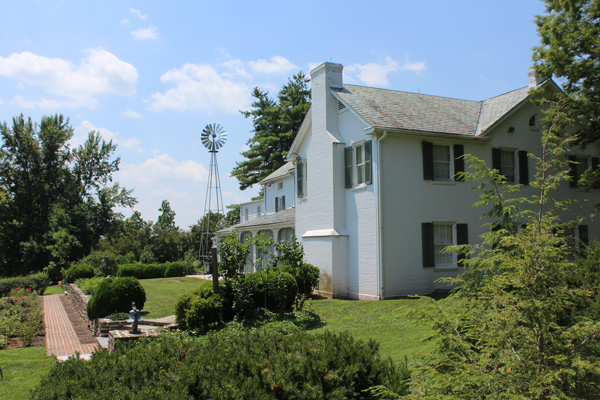
A view of the "back yard" area of Eisenhower's remodeled home.
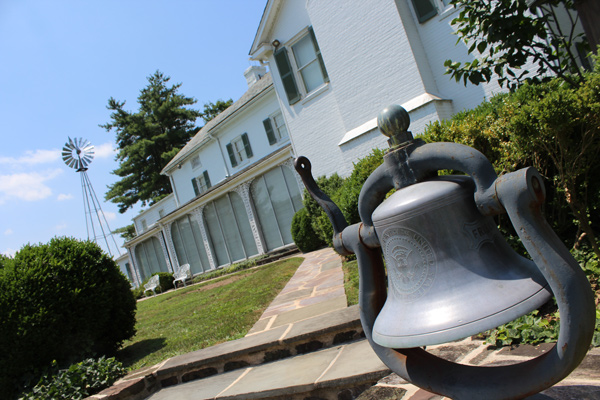
This bell was made from the melted fillings of the Nazi high command. Maybe.
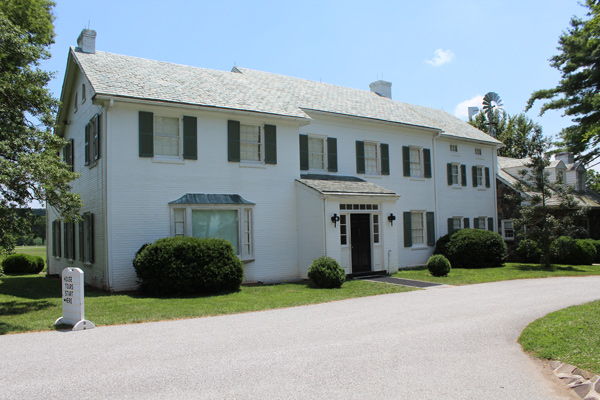
The main entrance to the home. Not so big, right?
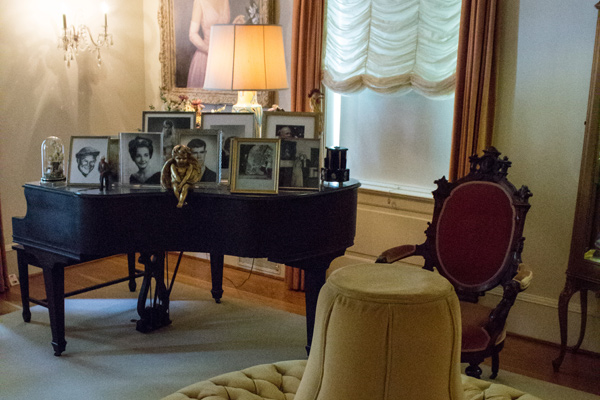
The obligatory photo-covered piano in every grandparent home.
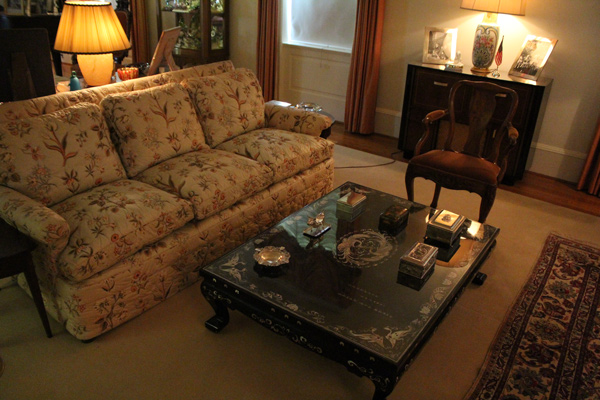
A view of the grandparent furniture in the living room. You can smell the '50s!
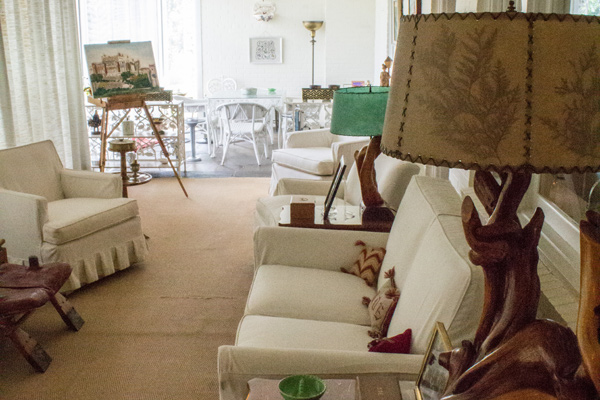
The porch. Note the easel in the back -- the light here was good for painting.
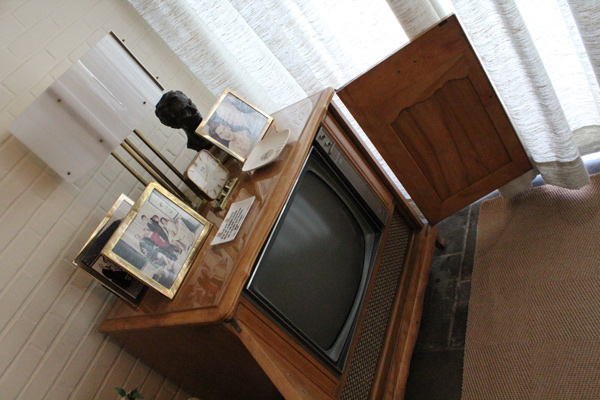
The radiation from this set is what REALLY caused his heart attack.
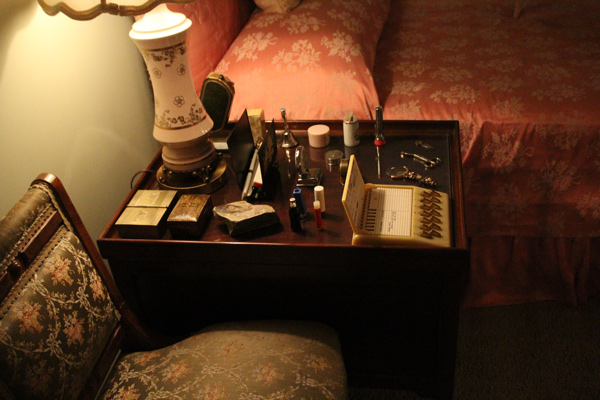
Mamie's nightstand and a peek at her pink bedspread. She lived there after Ike died.
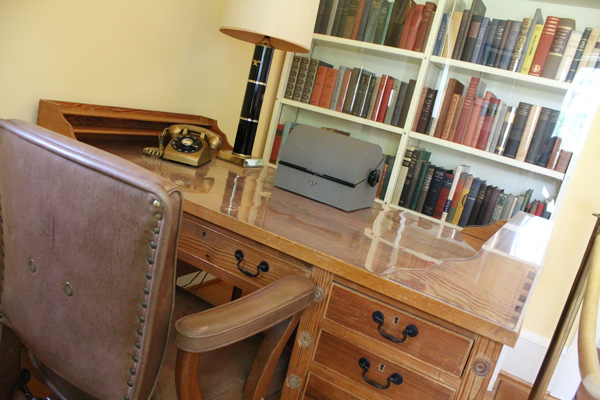
Ike's desk in the mudroom, unceremoniously crammed into house like an afterthought.
Dwight Eisenhower was homeless for most of his life.
Sure, he had places to live: military housing; apartments; rent-free inside Hitler's head. But Dwight and Mamie never owned a home, as his career required them to uproot their family ... well, before it ever put down roots. Mamie once estimated that she had to move around 60 times.
As the Eisenhowers got old, so did that lifestyle. When Ike was contemplating his retirement -- he was the president of Columbia University at the time -- he bought a run-down farmhouse in Gettysburg, Pa., with a few hundred acres attached. Ike liked the area. He had been stationed there during World War I, doing tank training at Camp Colt. He remained a huge Civil War buff. It wasn't too far from Washington, and he had friends who lived nearby.
His retirement, however, was delayed by a few part-time jobs. Eisenhower became the supreme commander of NATO, then the president of the United States. The renovations to the farmhouse were no longer a huge priority, as Ike was busy making the world safe from Communism and nuclear war and that sort of thing. Plus it takes a while to get the "old farm smell" out of a building. The place wasn't ready until 1955, late in Eisenhower's first term. But from that moment on, it was home sweet home.
You can't always "connect" with a president by visiting their home. Personally, I find it hard to truly relate to anyone who never enjoyed indoor plumbing, because ew, gross. But for a person my age, the Eisenhower ranch is fantastic. It's modest, charming, and straight out of the 1950s. It's your grandparents' house. Or it would be, if your granddad had personally defeated Hitler.
These days it's run by the National Park Service, and they're doing their usual bang-up job. You get there via shuttle bus from the Gettysburg battlefield visitors center. The bus is the only way in, and the only way out. It comes back to pick you up an hour later, so you gotta storm out the door like you're leaving a landing craft at Omaha Beach -- but an hour is plenty, because the Eisenhowers kept it simple.
They start you with a brief orientation speech, then move you into the living room -- which was probably the least lived-in room of the house. (Eisenhower found it "stuffy.") But it is the room filled with all the gifts Ike got as president or was able to loot from Nazi treasure troves. It still has the old folks touch: there's a baby grand piano with a ton of pictures on top of the closed lid, and there's a cabinet filled with weird figurines, as required by the Grandma Act of 1934.
After that, you get a brochure and free run of the house. (Within reason. You can't try on Mamie's bathrobe or anything fun like that.) It's a big house, but the Eisenhowers predated open floor plans, so it never feels liek a big house. There are a few guest rooms, a nice dining room, smallish bedrooms, normal bathrooms, cushy den chairs with afghans draped over the back and that sort of thing. Their favorite room of the house was the back porch: white cushions on the furniture, a driftwood lamp, and most important, the radiation-spewing television where they watched their stories.
Ike and Mamie liked TV, and why not? After a hard day of ruling the free world, who wouldn't want to relax for an hour or two a night? Together, they watched "I Love Lucy." (The cast even came to the White House for a state dinner.) Apart, Ike watched Westerns, while Mamie loved soaps. Apparently, she enjoyed "As the World Turns" so much that if she couldn't watch, she had a Secret Service agent take notes on the episode.
The porch is also where they display Ike's easel. Painting was a hobby Ike may have acquired from Winston Churchill, and as it turned out he wasn't bad. He did paintings of his grandkids, landscapes, and flowers ... not what you'd expect from a guy who in his spare time liberated Europe from the iron grip of fascism. Some of his originals are hanging around the home. Mamie has her flourishes all over the house, too: The upstairs bathroom and the master bedroom are pink -- her favorite color. The wallpaper in the entrance hall is a pattern she picked out of a catalog that has the seals of all 48 states and the territory of Hawaii (though as First Lady she was able to get a customized color scheme more to her liking). There's a kitchen she almost never used, as Ike was the better cook, and she said she could only make mayonaise and fudge.
The home saw some history, too. Eisenhower recovered from a mid-preisdency heart attack in the home, making it a temporary White House of sorts. He had a very tiny office office in the mudroom, right next to his den. It's where he got the first calls about Gary Powers being shot down over Russia. He signed bills in that mud room. Crazy. All the books around the house were owned by Eisenhower, and the guy had a taste for paperback Westerns, among other things.
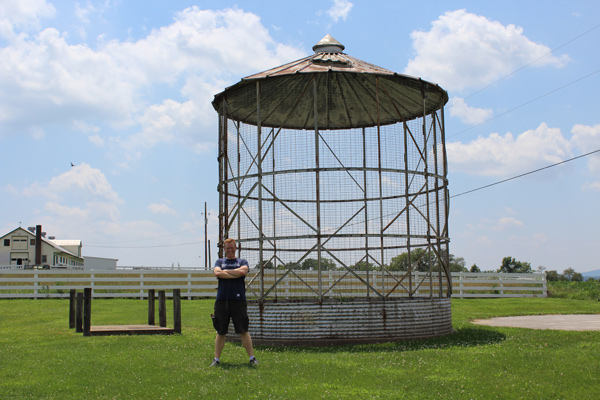
The cage where Ike kept Hitler captive. Maybe.

Reading the green. Must be nice to have the PGA be your landscaper.

So you know what direction the cow smell will be headed.
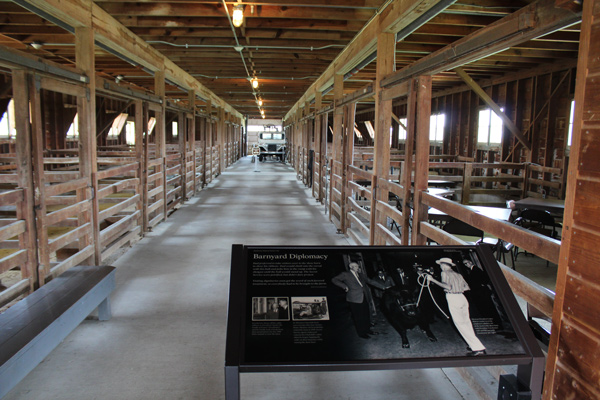
A view inside the "show barn" where all the prize cattle were on display.
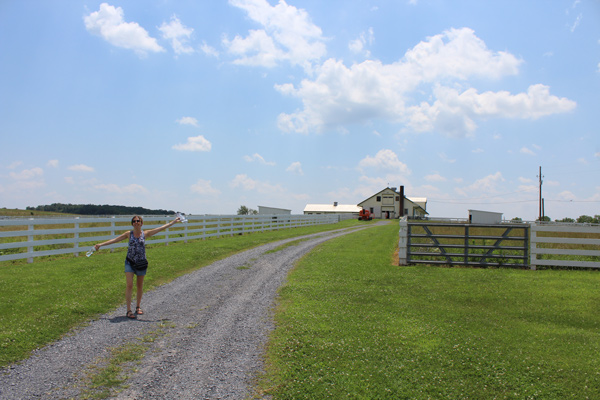
We're not in Kansas anymore. Seriously, it's Pennsylvania.
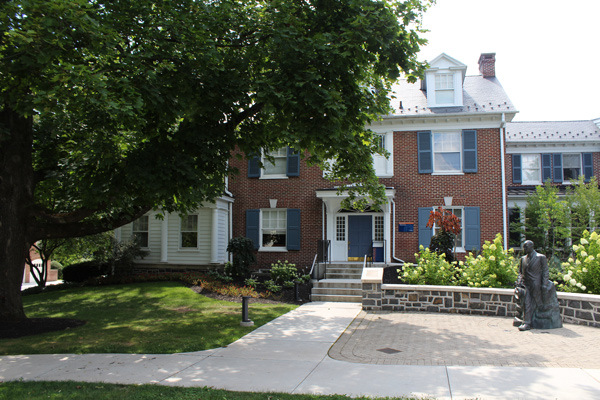
Eisenhower's old office space on the Gettysburg College campus.
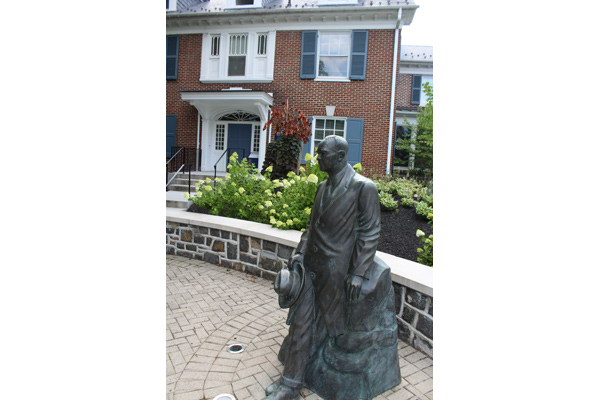
A closer look at the "at ease" statue in front of the admissions office.
And there's lots more than the home! The property was a functioning cattle ranch and farm, and a pretty good one at that. Eisenhower grew up in a cow town and he relished the chance to return to his roots. He wanted to breed prize cattle, and he would take visitors -- everyone from Churchill to Nehru -- on tours of the stables. Eisenhower would poke his favorite steer in the butt with a shotgun until it stood up, a display that apparently became very popular among guests and very unpopular with the Secret Service, which had to study ways to apply sleeper holds on Angus cattle. The Park Service still raises cattle on the property today.
There's a very visible reminder of the president's favorite hobby. The PGA "donated" putting greens to both the White House and Eisenhower's ranch, thereby allowing the president to stay sharp, in the event that the spread of Communism could only be stopped via a putting contest with Nikita Khrushchev.
And a special treat for any visitor to the farm would have been a stop by the outdoor cage where Eisenhower kept the captive Adolph Hitler. The story given to the public was that Hitler had committed suicide in a bunker as the Allies approached Berlin, and that his body was recovered by Russians who secretively hauled it back to the Soviet Union. But in fact, Eisenhower managed to arrange the capture of the German leader, who was then held in this simple pen, not far from the show barn. High-ranking visitors could squirt Hitler with a hose, yell names at him, blast non-stop klezmer music or force him to wrestle Eisenhower's prize cattle. Also, Mamie had his moustache dyed pink.
If you have extra time in Gettysburg, you should spend 10 to 29 hours on the battlefield. But if you have even more time than that, head downtown to the campus of Gettysburg College for one last bit of Eisenhower nostalgia. Although he had a lovely home, Eisenhower -- like all retirees suddenly spending 24 hours a day with their spouse -- saw the value of getting out now and then. He kept an office on the college campus, where he caught up on correspondence and worked on his memoirs. Today the building is the admissions office, where administrators have to review the much less impressive memoirs of 17-year-olds who never beat even a single fascist dictator. I guess they don't make 'em like they used to. Sigh.
The Ferdinand Magellan: Presidential Rail Car, 1943-1958
Visited in 2021.
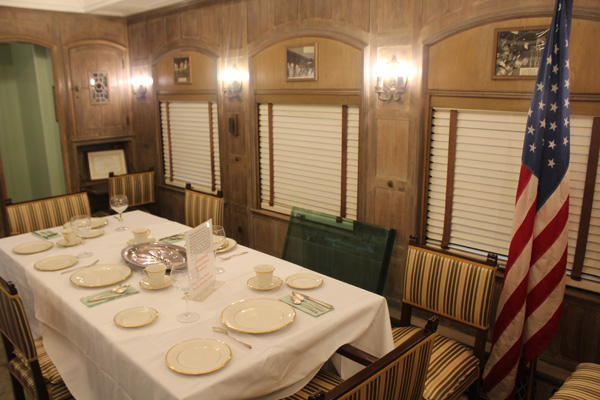
Fine dining at 35 mph. The dining car!
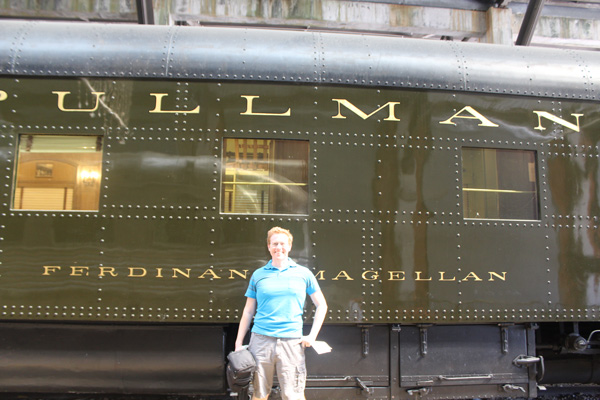
Checking out the armor plating (on the train, not my cargo shorts)
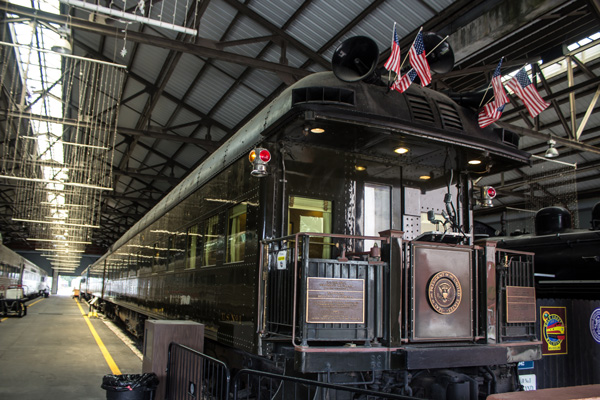
End of the line! The platform where Truman took his victory lap
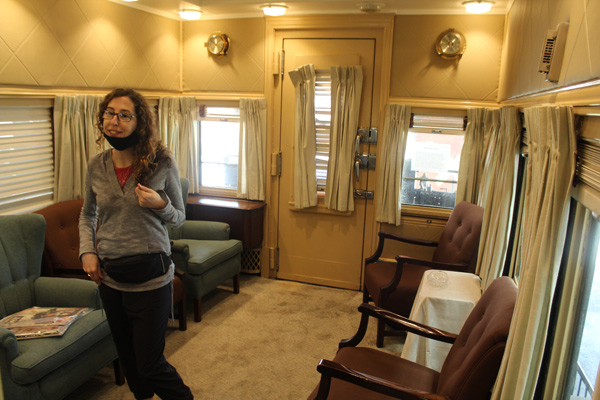
The lounge at the back of the president's rolling rumpus room.
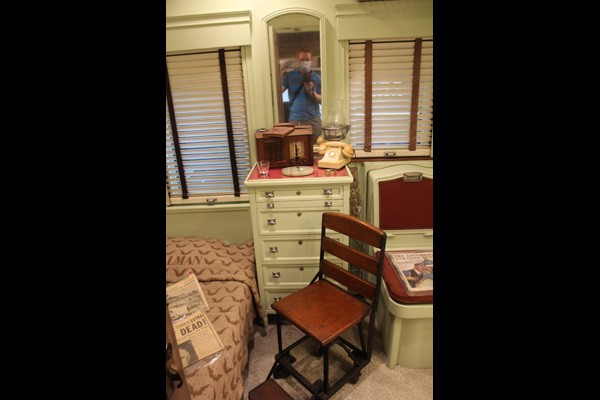
FDR's special accomodations.
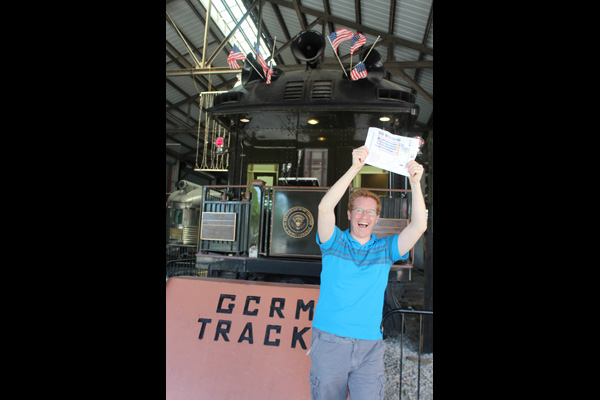
Dorky defeats embarrasment!
Air travel was a thing in the 1940s, but the industry hadn't quite figured out how to make it sexy. It wasn't fun to make out with your secretary when the engine noise was so loud, you'd never hear your wife approaching. You also couldn't have a delightful four-course dinner when random air pockets might launch the hot soup course onto your crotch at any moment. Why, that would make the canoodling even tougher!
No, in the 1940s, if you wanted discreet and sumptuous travel, rail was king. And the president of the United States deserved nothing less than the finest of rail cars. The Pullman Company was a luxury brand -- Abraham Lincoln's son had once been the president of the company! And you could modify a rail car to keep it safe from shadowy German saboteurs.
The Pullman company built six rail cars named after explorers -- although no one every explored anything via railroad -- and the U.S. government acquired the Ferdinand Magellan. It was modified with Nazi-proof armor plating, then put at the disposal of Franklin D. Roosevelt, a guy who knew something about rolling all over the place.
The Ferdinand Magellan served FDR, Harry Truman and Dwight Eisenhower before technological advances forced it into retirement. The government was ready to dump it on the ash heap of history, but the Gold Coast Railroad Museum -- in Miami -- snapped it up in the late 1950s. They have held it ever since, with a brief interlude to lend it to Ronald Reagan for a campaign event in 1984.
I finally got to visit this chariot of the gods in March 2021. (America was shut down, but Florida was open.) The first thing you need to realize about the Ferdinand Magellan: luxury is relative. Even after modifications -- a few bedrooms were converted into social areas -- it's not exactly spacious. The "hallway" between rooms is barely wide enough for my body, shoulder to shoulder -- so imagine the gymnastics required to get a customized FDR wheelchair back and forth. FDR enjoyed a little more personal space in his quarters, because his wife rarely traveled with him and took a separate cabin when she did. But it wasn't exactly the Ritz, and if he wanted to make time with his personal assistant everyone on board definitely would have known about it. He had the room to lay down, read a book, sign a few executive orders and not much else.
The dining room, at least, was the full width of the car. They squeezed in a decent sized dining table and slapped some wood paneling on the walls to class the place up; you could have a very classy dinner for eight, as long as no one was too beefy and everyone could hold their bladders for the course of the meal.
The observation lounge at the far end wasn't too bad, either. You could pal around with cronies or less-ethical journalists while relaxing in relatively comfortable chairs, watching the tracks disappear behind you. Of course, everyone was probably smoking, so the entire Ferdinand Magellan probably smelled like Satan's armpit. They would have been used to it back then, but the mustiness lives on today.
FDR rode about 50,000 miles in the Ferdinand Magellan, with his last trip being a dip down to his vacation home in Warm Springs, Georgia, in the spring of 1945. He used the train briefly when he was a corpse -- it carried his body up to Hyde Park for his funeral -- but they probably don't count that on his mileage totals.
It was Truman, however, that captured my imagination. Every news outlet had written Harry off in 1948, but he never gave up hope. The Magellan was one of his secret weapons, as he crossed the country in a whistlestop campaign and gave hundreds of speeches from the back platform. (It was rigged up with a presidential podium and a decent speaker system for just such occasions.) He was on the Magellan a few days after his victory, when someone handed him a copy of the Chicago Tribune with the famously flubbed headline, "Dewey Defeats Truman." He held it up for the crowds while standing on the back of the Magellan, posing for what is now one of the most famous photos in American history.
The Gold Coast Railroad Museum won't let you stand on the platform, but we got there early enough that they gave us free run of the interior. (The docent hadn't showed up yet.) They also have displays in other cars of past train menus (with a disturbing number of courses) and some info about how many workers it took to make the Magellan run. If you think the president was a little cramped, imagine where they stashed the gaggle of black and Filipino stewards who had to make the whole journey seem effortless.
It's a monument to another era -- and the timeless elegance of rail travel. Chugga chugga choo choo, y'all.
